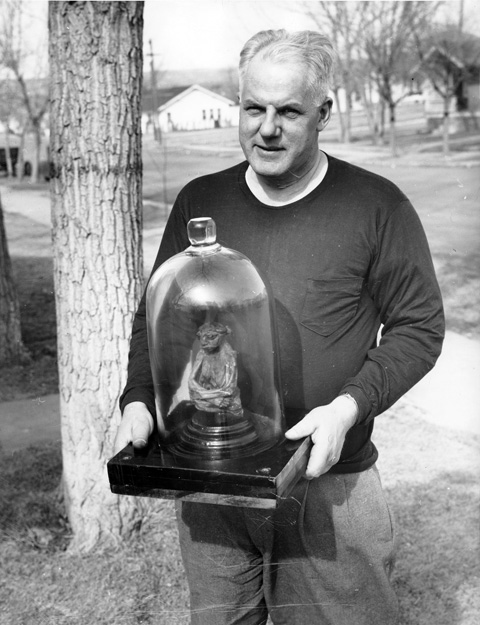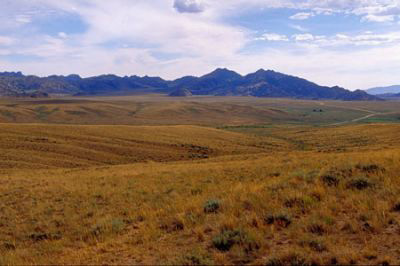- Home
- Encyclopedia
- The Pedro Mountain Mummy
The Pedro Mountain Mummy
A celebrity might have a brief career, or be famous for decades, even living on in public memory after death. But has an infant ever achieved this status?
The Pedro Mountain Mummy was discovered in June 1934 by two gold prospectors in the Pedro Mountains approximately 60 miles southwest of Casper, Wyo. Contrary to the mythology of the nearly eight decades that have passed since its discovery, the mummy was almost certainly a human baby, not a tiny adult from the Pliocene Epoch or from the race of Little People of American Indian lore.

Photographs and a signed affidavit leave little doubt that the discovery itself was real. The affidavit, dated Nov. 13, 1936 and signed by Cecil Main, one of the prospectors, states that the mummy was "found in a sealed cave, on a rock ledge about two and one half feet from the ground…there was nothing else in the cave." The affidavit further states that the mummy was "now owned by Homer F. Sherrill, and located in the Field Museum in Chicago, Illinois." The affidavit was sworn in Scotts Bluff County, Neb., and subsequently recorded in Hot Springs County, Wyo., on Aug. 16, 1943.
From the time of its discovery until it was lost in 1950, the mummy traveled a path that will probably never be possible to document fully. An article by Penelope Purdy in the Casper Star-Tribune dated July 21, 1979, states that the two prospectors "took the mummy back to Casper with them as a curiosity. Although they were ridiculed for perpetrating a hoax, the body made the rounds of local sideshows in a glass bottle. . . ."
Lou Musser wrote in a March 30, 1950, article for the Casper Tribune-Herald that the mummy for years “has been the center of much controversy locally." Musser notes that before it was purchased by Ivan Goodman, a Casper businessman, it was displayed by a prior owner in the Jones Drugstore in Meeteetse, Wyo. Although Musser does not name either the Meeteetse owner's name nor the price Goodman paid, Purdy mentions a selling price of "several thousand dollars." In a related article dated July 24, 1979, Purdy names the Meeteetse owner, Floyd Jones.
If the affidavit was dated in the same year as the discovery, both Purdy's 1979 article, as well as Musser's from 1950, have errors. Purdy states that the mummy was found in October 1932, according to "local legend." Musser reports that a sheepherder discovered it, naming no date.
To further confuse matters, an Oct. 21, 1977 newspaper article, "McAuley's Wyoming," also from the Casper Star-Tribune and obviously written somewhat tongue-in-cheek, claims, "Goodman…said he bought the Pedro Mountain Man from the sheepherder." This article also mentions that the sheepherder discovered it. This mythical sheepherder is not named in any of the articles that refer to him.
Even the sworn claim that the mummy was at the Field Museum is open to question. Archivist Armand Esai notes that the Field Museum has no record of the mummy's presence during that time. The item still could have been there on loan or for identification, but because it was not part of the museum's official collection, the mummy was not listed in the records.

Thus, facts discovered after the recording of the affidavit are sketchy, but Ivan Goodman's ownership by 1950 is certain. This was confirmed by his son Dixon Goodman of Casper. The elder Goodman took the mummy to Dr. Harry Shapiro, curator of biological anthropology at the American Museum of Natural History in New York City. Shapiro examined it, took X-rays and sent the films around that time to George Gill, then professor of biological anthropology at the University of Wyoming.
Gill has confirmed that he received those X-rays and that he and Shapiro agreed that the mummy was almost certainly a human baby, either stillborn or dead shortly after birth. This child probably died of anencephaly, the congenital absence of a large part of the brain.
Later in 1950, when Goodman traveled to New York a second time, he took the mummy to a man named in three articles as Leonard Wadler: Purdy's July 24, 1979 article, mentioned above, plus another by her dated Oct. 9, 1990 and one by John Bonar in the 62nd Annual Wyoming Chronicle, dated March 23, 1980. Bonar adds that a Casper librarian "claims that…Wadler…acquired…[the mummy] for study…" All three articles state that shortly after taking the mummy to Wadler, Goodman was taken ill and died. The mummy was never returned to Goodman's family, and has not been seen again.
This absence of 63 years has not daunted mummy-seekers nor believers in little people or in human pygmy lore. Well before 1950, the sensational press had begun, exemplified by an Aug. 17, 1941, Milwaukee Journal article, "Did a Race of Pygmies Once Live in America?" According to this account, the mummy was a tiny man, 65 years old at the time of death. This seems to have been the consensus before the findings of Shapiro and Gill.
The Milwaukee Journal stated, "discernible by X-ray is the food in the stomach, which appears to have been raw meat. The teeth in the front of the mouth are pointed and of the flesh-eating variety." More compelling yet is the groan of despair supposedly uttered by one of the gold prospectors, upon finding the mummy: "'The curse of the Pedro Chain is upon us!!...Looks like our number is up. . . .'"
Like the child's game where everyone sits in a circle and whispers into his neighbor's ear the words he thought he heard whispered into his own ear, the story continued to change and grow. For example, In "Wyoming's Mystery Mummy," a chapter in Stranger Than Science, published in 1959, author Frank Edwards observes that the mummy's "twisted lips [were] set in a sardonic half grin." This author also repeats the incorrect discovery date of October 1932.
Wyoming history enthusiast Robert David, in a March 11, 1962 Casper Tribune-Herald and Star article, also reports the find date as October 1932. David cites the Pedro Mountain Mummy as a source of "present knowledge of…little people," recounting several legends told by old Shoshone and Arapaho chiefs. One legend states that "…a large mob of pygmies…attacked us viciously, and threatened to kill us all."
An Internet article, "Little People and the Pedro Mountain Mummy," explains that many believe little people are legends, names the Pedro Mountain Mummy and refers to Shoshone legends that contain the belief that little people attack "with tiny bows and poisoned arrows."
The mummy, if it ever turns up again, would be subject to the Native American Graves and Repatriation Act as it is almost certainly the body of an American Indian child taken from a grave. NAGPRA, as the act is called, provides a process for the return of certain American Indian cultural items, including human remains and funerary objects, to the lineal descendants or culturally affiliated tribes whenever possible, and particularly when the items were found unexpectedly on federal land, as is most likely the case here.
In the early 1990s, interest in the mummy remained strong. A popular episode of the television series, Unsolved Mysteries, filmed in 1994, featured the story and included an interview with Dr. Gill. As a result, a Wyoming rancher brought him another mummy, which was found in 1929 or thereabouts in the Pedro Mountain area. Gill sent it to the Denver Children's Hospital and also examined it himself, obtaining X-rays, a DNA sample and a radiocarbon date. These results, Gill said, "confirmed everything that I had ever thought” about the Pedro Mountain Mummy, including the diagnosis of anencephaly.
Is the Pedro Mountain Mummy gone for good? It seems likely, and with no immediate prospect of testing and study, those carried away by myths and speculation will continue in the spirit of Irish poet William Allingham's The Fairies:
Up the airy mountain,
Down the rushy glen,
We daren’t go a-hunting
For fear of little men.
Resources
Primary Sources
- Affidavit by Cecil Main, Nov. 13, 1936, file "Mummies, Wyoming," Casper College Western History Center, Casper, Wyo.
Secondary Sources
- "Did a Race of Pygmies Once Live in America?" Milwaukee Journal, Aug. 17, 1941, 33. Accessed March 11, 2013, at http://news.google.com/newspapers?id=i15QAAAAIBAJ&sjid=Dg4EAAAAIBAJ&pg=5374,2889228&dq=pedro+mountain+mummy&hl=en.
- Bonar, John A. "'Little People' Tales Add to Casper Lore," 62nd Annual Wyoming Chronicle, March 23, 1980. File, "Mummies, Wyoming," Casper College Western History Center, Casper, Wyo.
- David, Robert B. "The Heritage of the Wind," Casper Tribune-Herald and Star, March 11, 1962. File, "Mummies, Wyoming," Casper College Western History Center, Casper, Wyo.
- Edwards, Frank. “Wyoming’s Mystery Mummy.” In Stranger Than Science. New York: Lyle Stuart, 1959, 118-120.
- Esai, Armand. Archivist, Field Museum, Chicago, Ill. Email to the author. March 12, 2013.
- Gill, Dr. George. Professor, Biological Anthropology, University of Wyoming, retired. Email to the author. March 6, 2013.
- "Little People and the Pedro Mountain Mummy." Accessed March 17, 2013, at http://www.legendsofamerica.com/wy-littlepeople.html.
- McAuley, Phil. "McAuley's Wyoming," Casper Star-Tribune, Oct. 21, 1977. File, "Mummies, Wyoming," Casper College Western History Center, Casper, Wyo.
- Musser, Lou. "Pedro Mummy Intrigues East," Casper Tribune-Herald, March 30, 1950. File, "Mummies, Wyoming," Casper College Western History Center, Casper, Wyo.
- National Park Service. “National NAGPRA.” U.S. Department of the Interior, accessed May 3, 2013 at http://www.nps.gov/nagpra/FAQ/INDEX.HTM#What_is_NAGPRA?.
- Purdy, Penelope. "Old Theory Discounted: Mummy Thought to be a Child," Casper Star-Tribune, July 21, 1979. File, "Mummies, Wyoming," Casper College Western History Center, Casper, Wyo.
- Purdy, Penelope. "Casper Indian Mummy Still Missing," Casper Star-Tribune, July 24, 1979. File, "Mummies, Wyoming," Casper College Western History Center, Casper, Wyo.
- Purdy, Penelope. "Missing Mini-Mummy Tickles Youthful Fancy," Casper Star-Tribune, Oct. 9, 1990. File, "Mummies, Wyoming," Casper College Western History Center, Casper, Wyo.
Illustrations
- The photo of Robert David holding the mummy in a jar is from the David Collection, Casper College Western History Center. Used with permission and thanks.
- The photo of the Pedro Mountains is from the Bureau of Land Management. Used with thanks.
